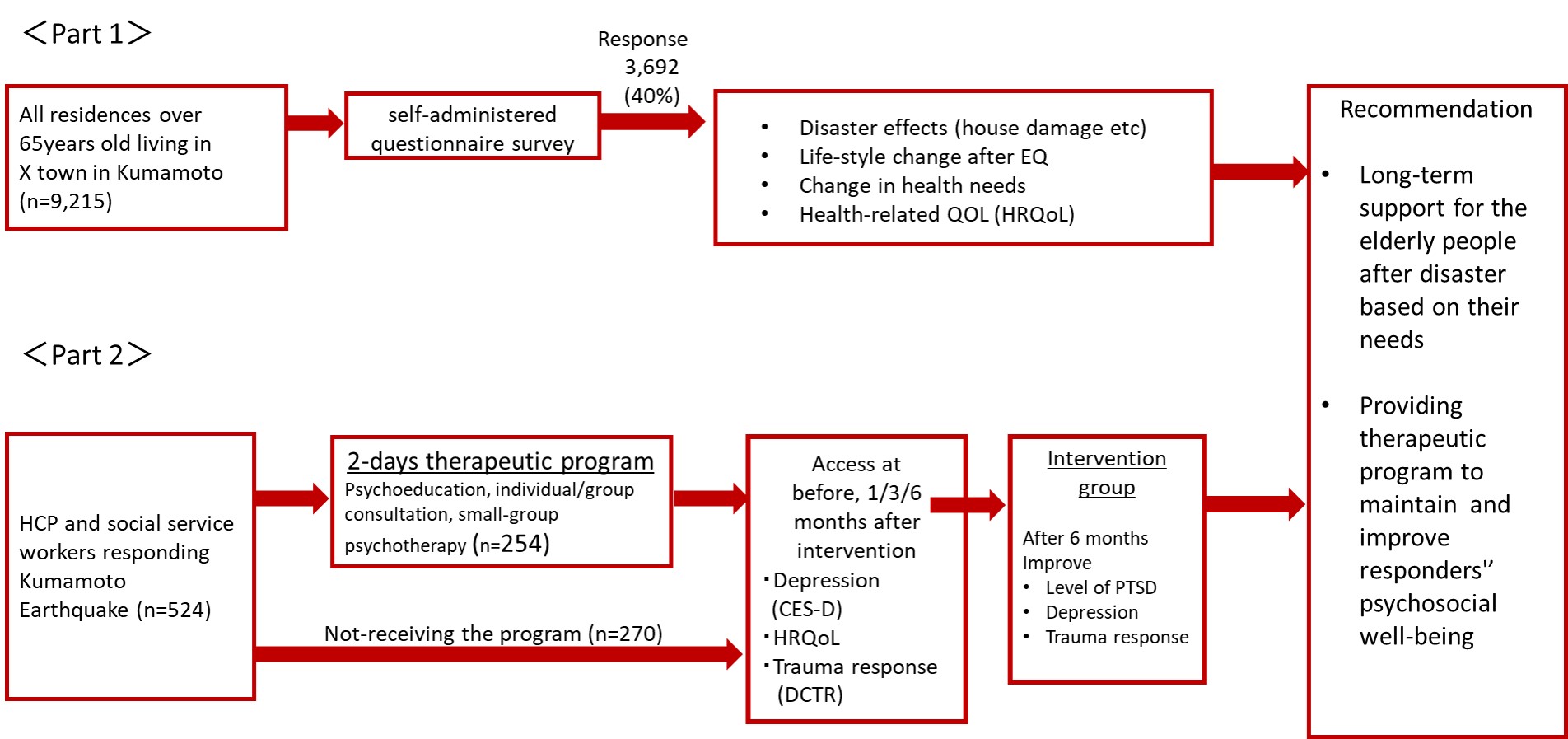
February 2018 to November 2019
Lead research institution: University of Hyogo
Other participating research institution: Kumamoto University
Principal investigators: Dr Aiko Yamamoto, Research Institute of Nursing Care for People and Community, University of Hyogo
Japan
Background
The increasing scale and frequency of disasters has placed a priority on the mitigation of disaster risk and impact. Of special interest is disaster risk management for health, with attention towards vulnerable populations. Older adults are more likely to have physical, cognitive and mental vulnerabilities, such as multiple chronic diseases that can worsen during and after disasters and be complicated by mental health issues such as post-traumatic stress disorder (PTSD) and depression. Healthcare and social service providers affected by disasters are also of concern in terms of the prevention of PTSD and depression, as they are required to keep working under stressful environments.
The current research project was conducted within the context of the 2016 Kumamoto earthquakes that affected over 180,000 people in Japan. It included two studies. The first study aimed to identify the needs and health status of older adults in Town X, one of the most severely damaged areas close to the hypocentre. The second study evaluated the impact of a two-day therapeutic programme among healthcare and social service providers directly affected by the Kumamoto earthquakes. The programme included a psychoeducation intervention, open and individual consultations, and a small-group psychotherapy designed to prevent post-traumatic stress disorder (PTSD) and depression.
Goal
To assess the health status, quality of life, needs for long term care, and changes in lifestyle of people over 65 years affected by the 2016 Kumamoto Earthquakes.
To conduct a therapeutic intervention programme among healthcare and social service providers affected by disasters to evaluate its feasibility, relevance, acceptability and impact on the prevention of PTSD and depression.
Methods
A letter-based questionnaire was sent to all 9,215 citizens over 65 years in Town X three years after the Kumamoto earthquake to collect information about socio-demographic characteristics; disaster effects (e.g. house damage; effect on household finance; requirement of evacuation); lifestyle change after the disaster (e.g. eating habits; daily activities; social activities; and change in health needs before and after the disaster (e.g. long term care, health-related quality of life (HRQoL) as measured with the Short Form (SF)-8.
To evaluate the impact The Centre for Epidemiologic Studies Depression Scale (CES-D); SF-8; and a sheet of dynamic change for trauma response (DCTR)) before, one month, three months, and six months after the intervention.
Results
A total of 3,692 older adults affected by the earthquake (40% of targeted participants) responded to the letter-based survey. Thirty percent of the participants reported a decrease in the frequency of going out and socialization after the earthquake. The need for long term care and support increased three years after the earthquake, and deterioration of the level of needed care and support was observed in 7% of the respondents. Lastly, respondents’ HRQoL scores were lower compared to the national standards: 48.2 versus 49 in males and 46.4 versus 49.3 in females for the physical component score of HRQoL, and 49.3 versus 51.3 in males and 47.6 versus 50.7 in females for the mental health component score of HRQoL.
The therapeutic intervention programme included 254 participants, of which 92.5% were nurses. Between the baseline and 6 months post intervention, the level of PTSD declined from 39% to 19% (p < 0.01), the CES-D average score decreased from 22.8 to 22.3 (p<0.05); and the DCTR average score declined from 8.3 to -2.4 (p<0.01). However, the change in HRQoL was not statistically significant: the average physical component score declined from 43.5 to 41.1 (p >0.05), while the average mental component score was increased from 40.9 to 42.6 (p >0.05).
Implications
Our sample of older adult survivors of the Kumamoto earthquakes displayed lower levels of HRQoL and experienced increased need for care and support three years after the earthquake. The proportion of healthcare and social providers with PTSD was reduced by half following the intervention; however, the lack of a comparable control group limits the assessment of the effectiveness of this therapeutic intervention.


